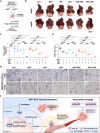Androgen receptor promotes arachidonic acid metabolism and angiogenic microenvironment in AFP-negative hepatocellular carcinoma
- PMID: 40651942
- PMCID: PMC12255818
- DOI: 10.1038/s41467-025-61448-z
Androgen receptor promotes arachidonic acid metabolism and angiogenic microenvironment in AFP-negative hepatocellular carcinoma
Abstract
Alpha-fetoprotein (AFP) is a classic biomarker for hepatocellular carcinoma (HCC). AFP-positive HCC (AFP+ HCC) has been intensively investigated; however, the genomic, transcriptomic and microenvironmental characteristics of AFP-negative HCC (AFP- HCC) remain to be deciphered. Here we show that tumors display mild differences in genetic alterations between AFP- HCC and AFP+ HCC patients, while AFP- HCC exhibits hyperactive arachidonic acid metabolism. Furthermore, the transcription activity of androgen receptor (AR) is significantly increased in AFP- HCC and plays a positive regulatory role in arachidonic acid metabolism and its metabolite 11,12-epoxyeicosatrienoic acid (11,12-EET). The tumor-derived 11,12-EET exhibits high affinity for EGFR that promotes the migration and tube formation of endothelial cells in vitro. Combination of lenvatinib and bicalutamide (an AR antagonist) enhances the therapeutic efficacy for AFP- HCC. Overall, we uncover the AR-mediated hyperactive arachidonic acid metabolism in AFP- HCC, and reveal AR-11,12-EET-EGFR axis-induced angiogenesis, providing a promising strategy of combined AR antagonist with lenvatinib for AFP- HCC treatment.
© 2025. The Author(s).
Conflict of interest statement
Competing interests: The authors declare no competing interests.
Figures







References
MeSH terms
Substances
Grants and funding
LinkOut - more resources
Full Text Sources
Medical
Research Materials
Miscellaneous

